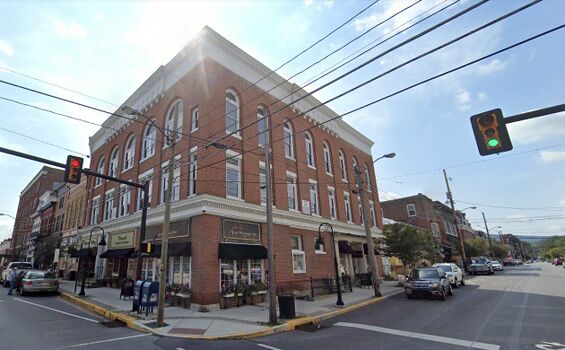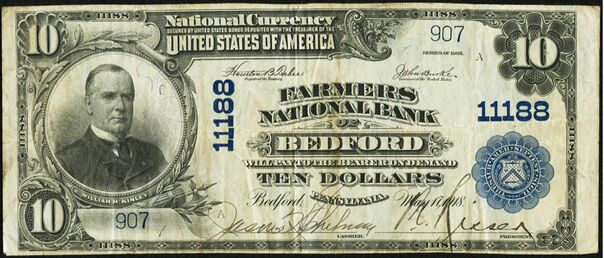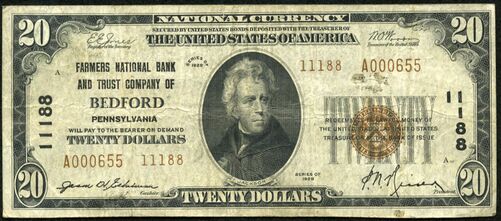Broad Top NB of Coaldale/Farmers NB of Bedford, Coaldale/Bedford, PA (Charter 11188)
Broad Top NB of Coaldale/Farmers NB of Bedford/Farmers NB & TC, Coaldale/Bedford, PA (Chartered 1918 - Receivership 1934)
Town History
Coaldale and Bedford are located in Bedford County.
Coaldale is a borough in Bedford County, Pennsylvania. It is surrounded by Broad Top Township and sits in the valley of Six Mile Run, a tributary of the Raystown Branch of the Juniata River. It is 8 miles south of the head of Raystown Lake and 26 miles northeast of Bedford, the county seat. The post office serving Coaldale is called Six Mile Run and dates back to 1851. As of the 2020 census the borough population was 128. In 1900 the population was 348, declining to 250 by 1930.
Bedford is a borough and spa town in and the county seat of Bedford County, Pennsylvania. It is located 102 miles west of Harrisburg, the state capital, and 107 miles east of Pittsburgh. Bedford's population was 2,861 at the 2020 census. In 1880 the population was 2,011 growing to 2,953 by 1930.
In 1758, the British Army under General John Forbes came to the vicinity of John Ray's trading post to set up Fort Bedford as a supply depot on the line of fortifications and supply depots between Carlisle and the Forks of the Allegheny River. The fort was named for John Russell, the politically powerful 4th Duke of Bedford in England. Fort Bedford was built as one of the many British Army stepping stones through the state from Carlisle leading west to the Forks of the Ohio River. In 1766, the village of Bedford was laid out by John Lukens; it would be incorporated on March 13, 1795. But because the citizens failed to fill the required posts at the time, the town had to be re-incorporated in 1816.
Coaldale (Bedford County, PA) had one National Bank chartered during the Bank Note Era, The Broad Top National Bank (Charter 11188) and it issued National Bank Notes. The Broad Top National Bank moved to Bedford and opened as the Farmers National Bank of Bedford, Charter 11188). Bedford, PA had four National Banks chartered during the Bank Note Era, and two of those banks issued National Bank Notes. In addition to the Farmers National Bank, The First National Bank of Bedford (Charter 3089) issued National Bank Notes.
NOTE: there is a second borough named Coaldale in Schuylkill County, PA that had one National Bank, The First National Bank of Coaldale (Charter 9739), that issued National Bank Notes.
Bank History
- Organized May 17, 1918
- Chartered June 7, 1918
- 3: Conservatorship March 28, 1933
- 3: Receivership October 26, 1934
The Broad Top National Bank of Coaldale
In February 1918, application was made to organize The Broad Top National Bank of Coaldale, Pennsylvania (post office Six Mile Run), capital $25,000.
On June 7, 1918, a charter was issued to the Broad Top National Bank of Coaldale, capital $25,000. The bank was about 38 miles south of Huntingdon, and served by the Six Mile Run post office.
On October 7, 1920, the Broad Top National Bank was closed by the comptroller of the currency and bank examiners were checking its affairs to find a shortage reported to be $38,000. John McIntyre, president and F.R. Cunningham, cashier, said the closing would only be temporary. The Bank had $130,000 in deposits and served a clientage principally of coal operators and miners. At the time of the shortage, the bank was closed for a few days, but re-opened and continued doing business.
On December 29, 1920, Frank R.N. Cunningham, former cashier of the Broad Top National Bank of Coaldale, Bedford County, charged with embezzlement and abstracting funds from the bank, was released under $10,000 bond. On motion of counsel for the defense, Judge W.H.S. Thompson, United States District Court in Pittsburgh, ordered the case continued over to the May term.
On April 26, 1921, a plea of guilty to four counts of abstraction of funds and one of embezzlement was entered in United States District Court by Frank R.N. Cunningham. Judge W.H.S. Thompson who heard the plea was informed that the funds in question had been replaced in the hands of the directors of the institution a short time before the shortage was discovered and that at the present the defendent held a responsible position with a firm at Six Mile Run. Final disposition of the case was made on December 7, 1922 when Mr. Cunningham was sentenced in Federal court in Pittsburgh to serve eight months in the Bedford County jail. Of the embezzled sums amounting to $43,947.01, most of the money was returned by the aged mother of the defaulter who mortgaged her home in New Jersey and by friends, the total refund being about $36,250.00. Cunningham was released from jail on Thursday, May 3, 1923.
Farmers National Bank of Bedford
In April 1923, Mr. P.N. Risser resigned from the Treasurership of the Bedford County Trust Company. He, in conjunction with Corle H. Smith, bought the Ridenour Block of Mrs. (Mary?) Wertz and it was rumored a new bank, hotel rooms and clothing house was contemplated for the building. As the board of directors would not accept the resignation, Mr. Risser agreed to serve until the shareholders meeting in January. However, in June, Mr. Clarence Diehl of the Bedford Garage was elected to fill the office of secretary treasurer of the Bedford County Trust Co.
In July 1923, according to present plans, the incorporators of the new Farmers' Bank would be P.N. Risser, Rush C. Litzinger, D.W.W. Diehl, S.U. Troutman, J.M. Horn, D.W. Beam, and Corle H. Smith. It appears this plan was not carried through. However, in December, Corle H. Smith, P.N. Risser, and Harold S. Smith made application to the state for a charter of an intended corporation to be called "The Smith Company" the character and object of which was to carry on the business of merchandising in clothing, shoes and wearing apparel.
In September 1925, approval was received from the comptroller of the currency for the establishment in Bedford of the Farmers National Bank with $50,000 capital, $30,000 surplus, and the absorption of the Broad Top National Bank of Six Mile Run, under the above title. Opening was planned on or about the 20th of October in the Ridenour Block owned by P.N. Risser. The purpose of the institution was to aid in the business boom which Bedford was enjoying, providing help to the people in general and farmers in particular.
The Farmers National Bank of Bedford was opened for business in temporary quarters on October 14, 1925, with a capital of $50,000. It was founded by Mr. P.N. Risser, one of Southern Pennsylvania's younger bankers. Mr. Risser had been instrumental in the development of a number of banks in this district. He founded the First National Bank of Claysburg in 1912 and served as cashier and vice president until 1915. His next venture was the organizing of the Bedford County Trust Company of Bedford, the first trust company founded in Southern Pennsylvania. He served as the secretary and treasurer from its opening until 1923 and continued as a director. A formal opening was held on October 24th. The Farmers' National Bank of Bedford, hosted hundreds of friends and patrons throughout the day, and all evening in the splendid, recently completed quarters at Pitt and Juliana Streets, formerly the Ridenour block. The hours for the public reception were set as 7 to 10 o’clock in the evening with orchestra music. The bank's new home was the last word in modern equipment. The vaults were of the latest design and the strongest in southern Pennsylvania. Three hundred tons of steel and concrete were used in their construction. The main door to the gigantic safe weighed 16 tons. Indiana limestone was used for the exterior and Italian marble finish with mahogany trim for the interior. The directors were J.M. McIntyre, H.C. James, D.W. Beam, James W. McIntyre, P.N. Risser, Corle H. Smith, and B.E. Cutchall. The officers were J.M. McIntyre, president; P.N. Risser, acting vice president; and Jason H. Eshelman, cashier.
In January 1926, Mr. Risser was elected president of the Farmers National Bank, having served as active vice president from the opening until that time. There were 13 banks in Bedford County and the Farmers National was the thirteenth, but Mr. Risser laughs at the suggestion of a “jinx”, explaining that "his institution is one of the strongest banks of the county with resources in excess of $400,000, capital of $50,000 and surplus and net profits of $32,500." The officers and directors included: John M. McIntyre, Six Mile Run, an active coal operator and vice president; Jason H. Eshelman of Everett, cashier. The directors were Dr. M.V. Brant, Cairnbrook; James M. McIntyre, Six Mile Run; B.E. Cutchall, Six Mile Run; Corle H. Smith, manager, Fort Bedford Inn; Harry C. James, attorney-at-law; D.W. Beam, hardware merchant; J.A.S. Beegle, farmer; and P.N. Risser, president.
On Tuesday afternoon, January 12, 1926, shareholders met at the Fort Bedford Inn where a turkey dinner was served to about 80 persons present. The following directors were named: J.M. McIntyre, P.N. Risser, B.F. Cutchall, Corle H. Smith, James M. McIntyre, Harry C. James, D.W. Beam, J.A.S. Beegle, and Dr. M.V. Brant. The officers elected were P.N. Risser, president; J.M. McIntyre, vice president; and H.C. James, secretary and solicitor.
In September 1926, the comptroller of the currency approved the application of the Farmers National Bank of Bedford to organize and open a trust company as of January 1, 1927. Amendments to the Federal Reserve Act now allowed national banks and trust companies to operate in one banking room with the same capital, board of directors, and employees with the single exception of a trust officer, thus establishing more efficient and wider services at greatly reduced operating expenses.
On Tuesday, January 11, 1927, stockholders met at the Fort Bedford Inn for the organization meeting. There were 201 stockholders, a large majority of which filled the main dining room to its capacity. After the lunch, President P.N Risser called the meeting to order. Beginning Monday, January 10th, the Farmers National Bank was changed to Farmers National Bank and Trust Company. The previous directors were re-elected as follows: P.N. Risser, Dr. M.V. Brant, J.A.S. Beegle, James McIntyre, John M. McIntyre, B.E. Cutschall, and H.C. James. The directors met and elected P.N. Risser, president; John M. McIntyre, vice president; H.C. James, secretary and soliciotr; and D. Cress Reiley, trust officer, a new office since the addition of a trust department.
In January 1933, the shareholders held their annual meeting in the directors' room in the bank building and elected the following directors: James McIntyre, John McIntyre, Dr. M.V. Brant, J.H. Laher, D.W. Beam, Corle H. Smith, Judge Harry C. James, J.A.S. Beegle and P.N. Risser. The directors met in the afternoon and elected the following officers: P.N. Risser, president; John M. McIntyre, vice president; J.H. Eshelman, cashier; C.H. Johnson and C.G. Culp, assistant cashiers; D.C. Reiley, trust officer; George A. Points, solicitor; and Jean Culp, stenographer.
On March 29, 1933, the Federal Reserve Bank of Philadelphia named Corle H. Smith conservator of the Farmers National Bank and Trust Company, Bedford, replacing A.B. Eglolf whose commission was revoked.
In August 1934, I.E. Jendricks, a former Johnstown banker, was appointed conservator. He succeeded Corle H. Smith who served as conservator since the bank holiday and who resigned due to ill health. The bank owned a three story building at Lincoln Highway and Juliana Street in Bedford which also housed three stores and 10 offices. Everett Press, Everett, PA, Fri., Aug. 17, 1934. In November 1934, Mark T. Bender, formerly cashier of the defunct Citizens' State Bank of Salisbury, was appointed receiver of the Farmers National Bank and trust Company of Bedford, an institution capitalized at $150,000. The bank had been in the hands of a conservator since March 1933 when President Roosevelt declared his bank holiday. Bender previously had a job in the offices of the Home Owners' Loan corporation, Johnstown Branch. The First National Bank and Trust Company of Bedford also went into the hands of a receiver on Saturday, Oct. 27th.
P.N. Risser, 82, prominent Bedford businessman and developer, died suddenly on Sunday morning, September 17, 1967, shortly after being admitted to the Memorial Hospital of Bedford County. During his career he opened three residential areas in the Bedford area and was instrumental in the founding of four banks. His other interests included an oil company, a motel and hotel. Phares N. Risser was the son of Levi and Amanda Risser of Elizabethtown, his father dying when he was three years of age. He attended Franklin & Marshall College. He bought the Moses Lipple merchandise store in Bedford and in 1912, organized the First National Bank of Claysburg. In 1918, he organized the Bedford County Bank in Alum Bank, and in 1914 was an organizer of the Bedford County Trust Co. in Bedford. In 1925, he reorganized the Farmer's National Bank and Trust Co. in the Ridenour Building. He served with that firm until the bank holiday in 1933. He built the first motor court in Bedford in conjunction with the Elmwood Inn and was active in financing the construction of the building which became the Fort Bedford Motor Inn. He established Penn Economy Oil and a system of stations for Cities Service oil products. From the family's Homestead Farm and Orchards, he developed Orchard Heights where he made his mansion home, The Oaks. He also developed Lakewood and Pennwood. In recent years, he had divided his home between Bedford and St. Petersburg, Florida. The Risser's lived in "The Oaks," their home in Orchard Heights, and wintered in "The Lone Pine," in St. Pete. He was a charter member of the Mount Joy Masonic Lodge, the Altoona Shrine, and a member of the United Church of Christ in Bedford. He was married to the former Bessie Blymer and she survived him along with two sons, P. N. Risser, Jr., of Florida, and Robert Risser of Bedford. There were four grandchildren and one great grandchild.
Official Bank Titles
1: The Broad Top National Bank of Coaldale, PA
2: Farmers National Bank of Bedford, PA (10/21/1925)
3: Farmers National Bank and Trust Company of Bedford, PA (7/25/1927)
Bank Note Types Issued
A total of $1,025,530 in National Bank Notes was issued by this bank between 1918 and 1934. This consisted of a total of 83,088 notes (43,476 large size and 39,612 small size notes).
This bank issued the following Types and Denominations of bank notes:
Series/Type Sheet/Denoms Serial#s Sheet Comments 1: 1902 Plain Back 3x10-20 1 - 3040 2: 1902 Plain Back 3x10-20 1 - 2979 3: 1902 Plain Back 3x10-20 1 - 4850 3: 1929 Type 1 6x10 1 - 4614 3: 1929 Type 1 6x20 1 - 1256 3: 1929 Type 2 10 1 - 3332 3: 1929 Type 2 20 1 - 1060
Bank Presidents and Cashiers
Bank Presidents and Cashiers during the National Bank Note Era (1918 - 1934):
Presidents:
Cashiers:
- Frank R.N. Cunningham, 1918-1919
- Edwin S. Gaster, 1920-1920
- Jason Hanks Eshelman, 1921-1932
Other Bank Note Signers
- John M. McIntyre signed notes as Vice President 1926...1933
- There are currently no known Assistant Cashier bank note signers for this bank.
Wiki Links
- Pennsylvania Bank Note History
- General information on Coaldale, Bedford County, PA (Wikipedia)
- General information on Bedford County (Wikipedia)
- General information on Pennsylvania (Wikipedia)
Sources
- Coaldale, PA, on Wikipedia
- Bedford, PA, on Wikipedia
- Don C. Kelly, National Bank Notes, A Guide with Prices. 6th Edition (Oxford, OH: The Paper Money Institute, 2008).
- Dean Oakes and John Hickman, Standard Catalog of National Bank Notes. 2nd Edition (Iola, WI: Krause Publications, 1990).
- Banks & Bankers Historical Database (1782-1935), https://spmc.org/bank-note-history-project
- The Brooklyn Daily Eagle, Brooklyn, NY, Sat., June 8, 1918.
- Reading Times, Reading, PA, Thu., Oct. 7, 1920.
- The Times Leader, Wilkes-Barre, PA, Thu., Dec. 30, 1920.
- The News Journal, Lancaster, PA, Wed., Apr. 27, 1921.
- Franklin Repository, Chambersburg, PA, Thu., Dec. 7, 1922.
- Bedford Gazette, Bedford, PA, Fri., Apr. 13, 1923.
- Bedford Gazette, Bedford, PA, Fri., Apr. 20, 1923.
- Bedford Gazette, Bedford, PA, Fri., June 15, 1923
- Altoona Tribune, Altoona, PA, Thu., June 14, 1923.
- Bedford Gazette, Bedford, PA, Fri., July 20, 1923.
- Bedford Gazette, Bedford, PA, Fri., Oct. 23, 1925.
- Bedford Gazette, Bedford, PA, Fri., Dec. 7, 1923.
- Bedford Gazette, Bedford, PA, Fri., Sep. 18, 1925.
- The Fulton Democrat, McConnellsburg, PA, Thu., Dec. 21, 1922.
- Pittsburgh Daily Post, Pittsburgh, PA, Tue., May 1, 1923.
- Altoona Tribune, Altoona, PA, Thu., Jan. 14, 1926.
- Altoona Tribune, Altoona, PA, Sat., Aug. 21, 1926.
- Bedford Gazette, Bedford, PA, Fri., Sep. 24, 1926.
- Bedford Gazette, Bedford, PA, Fri., Jan. 21, 1927.
- Altoona Tribune, Altoona, PA, Thu., Mar. 30, 1933.
- The Republic, Meyersdale, PA, Thu., Nov. 1, 1934.
- Bedford County Press and Everett Press, Everett, PA, Thu., Feb. 11, 1960.
- Bedford County Press and Everett Press, Everett, PA, Thu., Sep. 21, 1967.






